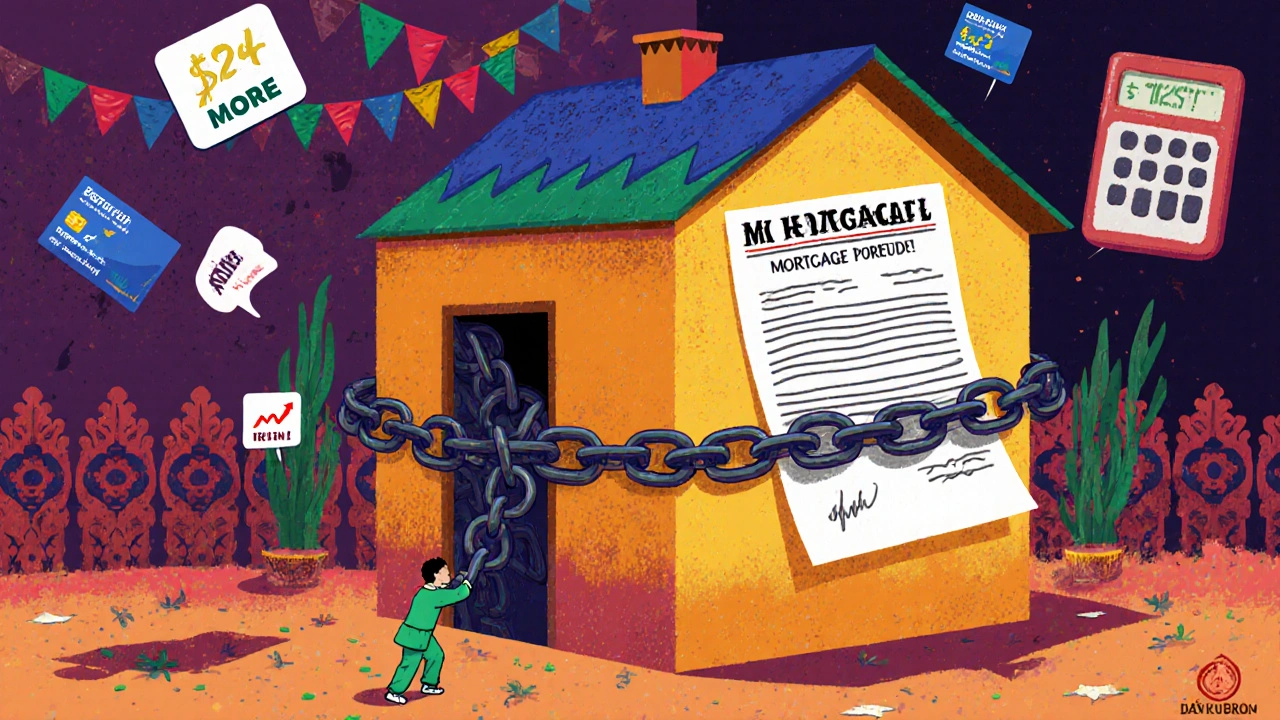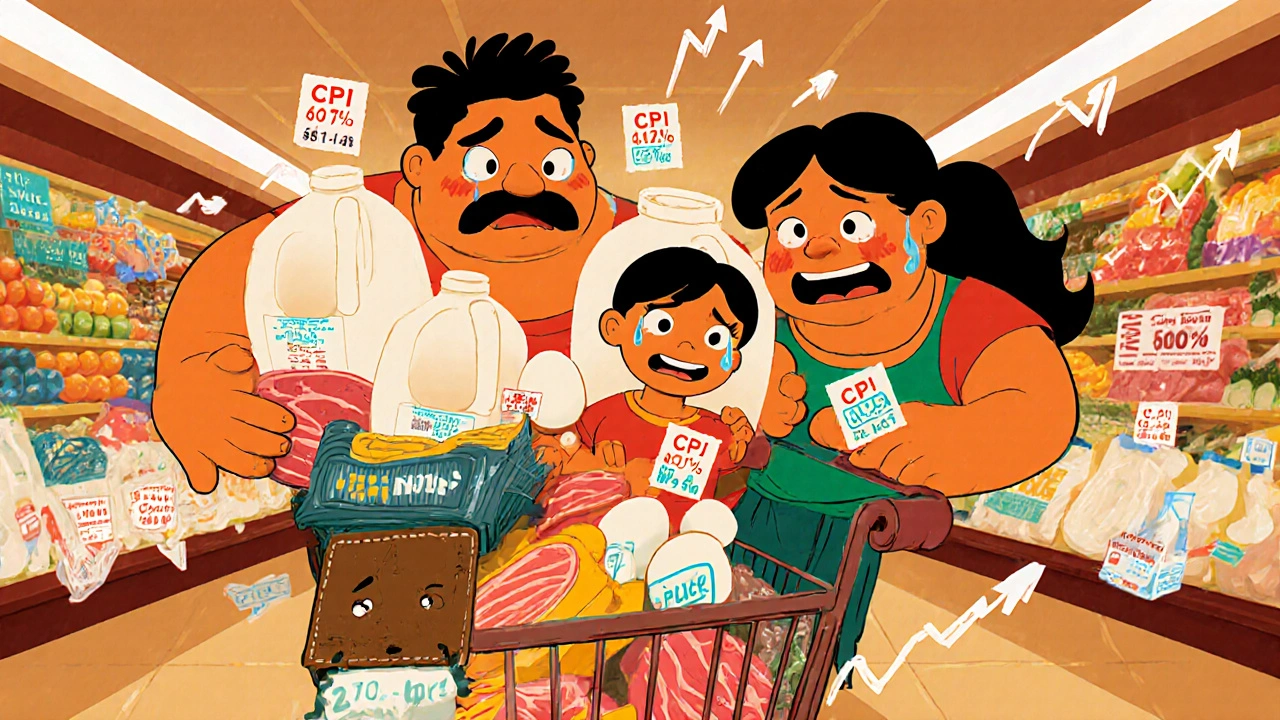What Inflation Really Means for Your Wallet
Inflation isn’t just a number you hear on the news-it’s the reason your grocery bill keeps climbing, your gas tank fills up faster, and that new car you were saving for feels farther away than ever. At its core, inflation is the steady rise in the average price of everyday goods and services. The U.S. government tracks this using the Consumer Price Index (CPI), which measures changes in prices for things like food, housing, transportation, and medical care. When inflation goes up, your dollar buys less. Simple as that.
Back in 2022, inflation hit 9.1%-the highest in over 40 years. That meant if you spent $100 on groceries in January 2021, you needed $109.10 to buy the same stuff by June 2022. Even though inflation has cooled since then, it’s still hovering around 3% as of mid-2024. That might sound manageable, but over time, even small increases add up. A 3% annual inflation rate means prices double in about 24 years. If you’re planning for retirement, that’s not a small deal.
Where You Feel Inflation the Most
Not all prices rise at the same pace. Some categories hit harder than others-and they don’t hit everyone equally. Lower-income households feel the squeeze the most because they spend a much bigger chunk of their income on essentials. According to Pew Research, people with lower earnings spend nearly two-thirds of their money on food, energy, and housing. Those categories were among the fastest-growing during the 2021-2024 inflation surge.
- Food: Grocery prices jumped 25.1% from early 2021 to mid-2024. Eggs, milk, and meat saw the biggest spikes.
- Energy: Gas and electricity costs rose 20.4% over the same period, thanks to global supply issues and oil price swings.
- Housing: Rent went up 8.2% in late 2022. Even though it’s slowed to 3.8% now, it’s still higher than pre-pandemic levels. Home prices climbed from $325,000 to $425,000 between 2021 and 2024.
- Transportation: New cars cost 13.3% more; used cars? Up a staggering 41.2% at their peak.
These aren’t abstract numbers. They’re what you see when you swipe your card at the checkout or open your utility bill. And here’s the kicker: even though wages rose about 5.6% in 2022, real wages-adjusted for inflation-actually dropped by 3.4%. That means most people earned more money but could afford less with it.
How Inflation Sneaks Into Your Debt
Inflation doesn’t just raise prices-it changes the cost of borrowing. The Federal Reserve fights inflation by raising interest rates. In early 2021, the federal funds rate was near zero. By mid-2023, it hit 5.5%, the highest in over two decades. That ripple effect hits your credit cards, auto loans, and mortgages.
Take mortgages. In January 2021, a 30-year fixed rate was around 2.65%. By June 2024, it jumped to 6.78%. For a $400,000 home loan, that’s an extra $924 per month. That’s more than your entire cell phone bill-or a full month’s worth of groceries. Even if you’re not buying a house right now, if you have variable-rate debt, your payments are probably higher than they were two years ago.
And credit cards? Average APRs hit 24.7% in April 2024. If you carry a balance, every dollar you owe is costing you nearly 25 cents a year just in interest. That’s not a loan-it’s a tax on not having cash saved.

How People Are Fighting Back
People aren’t just accepting higher prices-they’re changing how they spend. Reddit threads like “How I reduced my grocery bill by 27% during inflation” have thousands of upvotes because real people are sharing real tactics.
- Meal planning saves about $112 a month by reducing food waste and impulse buys.
- Switching to store brands cuts grocery costs by $45 a month-often with no noticeable difference in quality.
- Bulk buying non-perishables (toilet paper, detergent, canned goods) saves $78 a month when timed right.
Consumer Reports found that 68% of Americans cut back on discretionary spending. That means fewer dinners out, fewer movie tickets, fewer impulse Amazon orders. The average household cut $73 a month from entertainment alone. It’s not glamorous, but it works.
Some are also shifting their spending habits strategically. Instead of buying beef when prices soared, many switched to chicken or beans. The USDA estimates that simple swaps like this saved households about $287 a year. That’s like getting a free weekend getaway without leaving town.
What Smart Budgeters Do Differently
It’s not just about cutting back-it’s about protecting what you have. Financial experts have clear advice for people trying to shield their budgets from inflation.
- Keep 3-6 months of expenses in a high-yield savings account. As of mid-2024, accounts from Ally, Marcus, and Discover are paying 4-5% APY. That’s better than inflation-and safer than the stock market right now.
- Don’t spend more than 30% of your income on housing. But here’s the problem: 37% of U.S. households already exceed that. If you’re in that group, look for ways to reduce other expenses to balance it out.
- Use price-tracking tools. Sites like CamelCamelCamel show you historical prices on Amazon. People who used these tools saved an average of $1,247 a year on recurring purchases.
- Consider TIPS (Treasury Inflation-Protected Securities). These government bonds adjust their value with inflation. Investors added over $1.2 trillion to TIPS between 2021 and 2023 because they’re one of the few assets that grow as prices rise.
One of the most overlooked moves? Doing a quarterly “inflation audit” of your spending. Fidelity found that households who reviewed their budgets every three months reduced inflation-related stress by 18%. You don’t need to be a financial expert-just open your bank app, check what categories cost more, and ask: “Can I replace this with something cheaper?”

Why Your Paycheck Isn’t Keeping Up
Many people assume their employer gives them a cost-of-living raise every year. But that’s not always true. In 2023, the average raise was 4.2%. Meanwhile, inflation was 4.9%. That’s a 0.7% loss in real income-even if you got a raise.
Companies aren’t being stingy-they’re dealing with their own rising costs. But that doesn’t make it easier for you. If your raise doesn’t match inflation, your budget is shrinking. That’s why it’s critical to know your numbers: track your income, track your expenses, and compare them side by side every few months.
And if your employer doesn’t offer raises that match inflation? Start thinking about side gigs, skill upgrades, or even job hopping. The job market is still tight in many sectors. A 10-15% pay bump by switching companies is still possible-and sometimes the only way to catch up.
What’s Next for Inflation and Your Budget
The good news? Inflation is slowing. The Congressional Budget Office expects it to average 2.8% in 2024 and drop to 2.0% in 2025. That’s close to the Federal Reserve’s long-term target. But “slowing” doesn’t mean “gone.” Prices aren’t falling-they’re just rising more slowly.
The Federal Reserve’s “Sticky Price CPI,” which tracks items that rarely change price (like rent or insurance), has stabilized at 3.2%. That’s a sign that core inflation is becoming more predictable. For your budget, that means less surprise spikes. But it also means you can’t assume things will get cheaper. You still need to plan for steady, moderate increases.
Bottom line: Inflation isn’t a temporary glitch. It’s a permanent feature of modern economies. The goal isn’t to avoid it-it’s to manage it. Build habits now that protect your purchasing power: save more, spend smarter, track prices, and adjust your budget regularly. The people who come out ahead aren’t the ones who had the most money. They’re the ones who paid attention.
Is inflation always bad for my budget?
Not always. Low, steady inflation (around 2%) is normal and even healthy for the economy-it encourages spending and investment. The problem happens when inflation spikes unexpectedly, like it did in 2022. That’s when prices rise faster than wages, and people struggle to keep up. The key is predictability. If you know inflation is coming, you can plan for it.
Should I invest in stocks to beat inflation?
Long-term, yes-stocks historically outpace inflation. But not right now if you’re relying on that money in the next few years. The stock market can be volatile, and if you need cash for rent or groceries, you don’t want it tied up in investments that could drop. Focus on protecting your short-term budget first. Then, over time, build a diversified portfolio that includes stocks, bonds, and inflation-protected assets like TIPS.
How do I know if my savings are keeping up with inflation?
Compare your savings account’s APY to the current inflation rate. If your account pays 4.5% and inflation is 3%, you’re ahead. If your savings account pays 0.5% and inflation is 3%, you’re losing 2.5% of your buying power every year. Switch to a high-yield savings account-many pay 4-5% and are FDIC-insured. It’s free money you’re leaving on the table if you don’t.
Can I avoid inflation by buying less?
You can reduce its impact, but you can’t avoid it entirely. Even if you buy less, the prices of essentials like electricity, water, and medicine still go up. The goal isn’t to stop spending-it’s to spend smarter. Focus on cutting waste, not necessities. A $100 grocery bill that’s 25% more expensive doesn’t mean you should stop eating. It means you should plan meals, buy store brands, and avoid impulse purchases.
Will inflation go back to normal soon?
Most economists expect inflation to settle around 2% by 2025, which is considered normal. But “normal” doesn’t mean prices will drop-they’ll just rise more slowly. You should still plan for prices to increase 2-3% each year. That’s why building habits like budgeting, saving in high-yield accounts, and tracking expenses matters more than ever.

Julia Czinna
October 30, 2025 AT 12:54I’ve been using CamelCamelCamel for a year now and saved over $1,100 just on household staples. It’s not sexy, but it’s real money back. I track everything from laundry detergent to toilet paper-when the price dips below my target, I buy six months’ worth. No more panic buys at the checkout.
Also switched to store-brand peanut butter. Tasted identical. Saved $3.50 a jar. That’s $42 a year on one item alone. Inflation doesn’t win if you’re quietly ruthless about the small stuff.
Astha Mishra
October 31, 2025 AT 11:31It is truly fascinating, is it not, how the invisible hand of the market, once thought to be a benevolent force guiding prosperity, has now become a relentless tide eroding the foundations of daily life for the working class? Inflation, in its essence, is not merely an economic phenomenon-it is a social recalibration, a silent redistribution of wealth from those who labor to those who own capital.
And yet, in the midst of this, we find solace not in grand systemic change, but in the quiet dignity of meal planning and store-brand detergents. Is this our new form of resistance? To budget with the precision of a monk and the patience of a gardener? Perhaps. But I wonder-when the cost of a single egg exceeds the wage of a ten-minute bus ride, how long can dignity survive without justice?
Kenny McMiller
October 31, 2025 AT 21:08Bro, the Fed’s sticky price CPI at 3.2%? That’s the real story. Core inflation isn’t cooling-it’s just going latent. Rent and insurance are locked in like a 30-year ARM. And TIPS? Solid play, but you need to understand duration risk. If rates stay elevated, even inflation-adjusted bonds get hammered in the secondary market.
Also, 4-5% HYSA? Yeah, that’s nice, but it’s still a negative real return if you’re in a high-tax state. Municipal bond funds might be better for long-term savers. And stop treating your emergency fund like a savings account-put it in a money market fund with FDIC insurance and daily liquidity. Stop leaving cash in checking. You’re literally paying inflation to hold it.
Laura W
November 2, 2025 AT 15:27Y’all are overcomplicating it. Just do three things: 1) Switch to store brand. 2) Freeze half your groceries before they go bad. 3) Cancel one subscription you don’t use (you know which one).
I did this last year. Saved $2,100. Bought a used bike. Rode to work. No more gas. No more parking. No more stress. Inflation didn’t beat me-I just stopped playing the game the way they wanted me to.
Also, chicken > beef. Always. And beans? Free protein. You’re welcome.
Graeme C
November 4, 2025 AT 04:42Let’s be brutally honest-this entire system is rigged. Wages haven’t kept up because corporations are prioritizing shareholder dividends over worker survival. They call it ‘inflation’ like it’s some natural disaster, but it’s policy. Interest rates were raised to crush labor power, not to ‘cool the economy.’
And now we’re being told to ‘shop smarter’ while CEOs rake in record profits? That’s not resilience-that’s victim-blaming wrapped in a budgeting spreadsheet. If your ‘solution’ is switching to store-brand pasta while your boss gets a 300% bonus, you’re not managing inflation-you’re surviving exploitation.
Stop optimizing your budget. Start organizing your coworkers. Demand wage increases tied to CPI. Or keep eating beans while the rich buy islands.